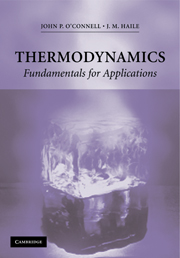Book contents
- Frontmatter
- Contents
- Preface
- Acknowledgments
- THERMODYNAMICS: Fundamental for Applications
- 0 Introduction
- PART I THE BASICS
- 1 Primitives
- 2 The First and Second Laws
- 3 Fundamental Relations
- PART II SINGLE-PHASE SYSTEMS
- PART III MULTIPHASE AND REACTING SYSTEMS
- PART IV ENGINEERING CALCULATIONS
- APPENDICES
- Notation
- Index
2 - The First and Second Laws
Published online by Cambridge University Press: 05 June 2012
- Frontmatter
- Contents
- Preface
- Acknowledgments
- THERMODYNAMICS: Fundamental for Applications
- 0 Introduction
- PART I THE BASICS
- 1 Primitives
- 2 The First and Second Laws
- 3 Fundamental Relations
- PART II SINGLE-PHASE SYSTEMS
- PART III MULTIPHASE AND REACTING SYSTEMS
- PART IV ENGINEERING CALCULATIONS
- APPENDICES
- Notation
- Index
Summary
Much of thermodynamics concerns the causes and consequences of changing the state of a system. For example, you may be confronted with a polymerization process that converts esters to polyesters for the textile industry, or you may need a process that removes heat from a chemical reactor to control the reaction temperature and thereby control the rate of reaction. You may need a process that pressurizes a petroleum feed to a flash distillation unit, or you may need a process that recycles plastic bottles into garbage bags. In these and a multitude of other such situations, a system is to be subjected to a process that converts an initial state into some final state.
Changes of state are achieved by processes that force the system and its surroundings to exchange material or energy or both. Energy may be exchanged directly as heat and work; energy is also carried by any material that enters or leaves a system. A change of state may involve not only changes in measurables, such as T and P, but it may also involve phase changes and chemical reactions. To design and operate such processes we must be able to predict and control material and energy transfers.
Thermodynamics helps us determine energy transfers that accompany a change of state. To compute those energetic effects, we can choose from two basic strategies, as illustrated in Figure 2.1. In the first strategy we directly compute the heat and work that accompany a process.
- Type
- Chapter
- Information
- ThermodynamicsFundamentals for Applications, pp. 32 - 68Publisher: Cambridge University PressPrint publication year: 2005



